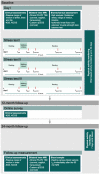Dose-response relationship of in vivo ambulatory load and mechanosensitive cartilage biomarkers-The role of age, tissue health and inflammation: A study protocol
- PMID: 35984848
- PMCID: PMC9390933
- DOI: 10.1371/journal.pone.0272694
Dose-response relationship of in vivo ambulatory load and mechanosensitive cartilage biomarkers-The role of age, tissue health and inflammation: A study protocol
Abstract
Objective: To describe a study protocol for investigating the in vivo dose-response relationship between ambulatory load magnitude and mechanosensitive blood markers of articular cartilage, the influence of age, cartilage tissue health and presence of inflammation on this relationship, and its ability to predict changes in articular cartilage quality and morphology within 2 years.
Design: Prospective experimental multimodal (clinical, biomechanical, biological) data collection under walking stress and three different load conditions varied in a randomized crossover design.
Experimental protocol: At baseline, equal numbers of healthy and anterior cruciate ligament injured participants aged 20-30 or 40-60 years will be assessed clinically and complete questionnaires regarding their knee health. Biomechanical parameters (joint kinetics, joint kinematics, and surface electromyography) will be recorded while performing different tasks including overground and treadmill walking, single leg balance and hopping tasks. Magnetic resonance images (MRI) of both of knees will be obtained. On separate stress test days, participants will perform a 30-minute walking stress with either reduced (80% body weight (BW)), normal (100%BW) or increased (120%BW) load. Serum blood samples will be taken immediately before, immediately after, 30, 120 and 210 minutes after the walking stress. Concentration of articular cartilage blood biomarkers will be assessed using enzyme linked immunosorbent assays. At 24-month follow-up, participants will be again assessed clinically, undergo an MRI, complete questionnaires, and have a blood sample taken.
Conclusion: The study design provides a standardized set up that allows to better understand the influence of ambulatory load on articular cartilage biomarkers and thereby extend current knowledge on in vivo cartilage metabolism and mechanosensitivity. Further, this study will help to elucidate the prognostic value of the load-induced cartilage biomarker response for early articular cartilage degeneration.
Trial registration: The protocol was approved by the regional ethics committee and has been registered at clinicaltrials.gov (NCT04128566).
Conflict of interest statement
The authors have declared that no competing interests exist.
Figures





References
Publication types
MeSH terms
Substances
Associated data
LinkOut - more resources
Full Text Sources
Medical

